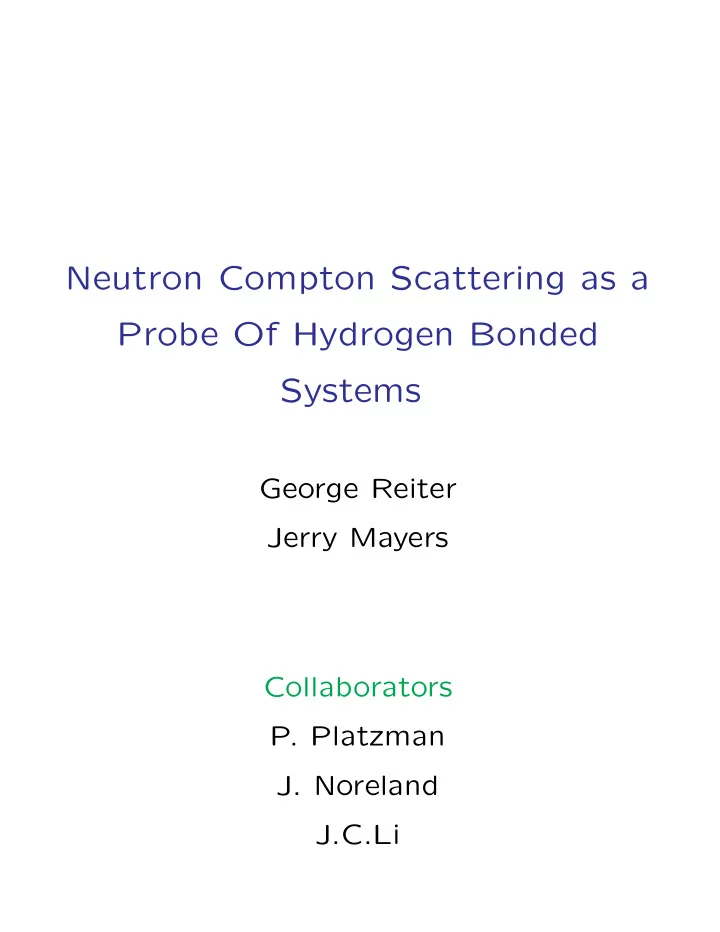

Neutron Compton Scattering as a Probe Of Hydrogen Bonded Systems George Reiter Jerry Mayers Collaborators P. Platzman J. Noreland J.C.Li
Outline How do You Extract the Momentum Dis- tribution? How Much Detail Can One See? How Does Tunnelling Show Up? Results For KDP Results for Water and Ice
Neutron Scattering in the Impulse Approximation Limit Deep Inelastic Neutron Scattering � n ( � hq 2 p ) δ ( ω − ¯ 2 M − � p.� q S M ( � q, ω ) = M ) d� p ¯ hω is the energy transfer, M is the mass of the tar- get particle, q= | � q | is the magnitude of the wavector transfer and n( � p ) is the momentum distribution. � n ( � q, ω ) = M p = M S M ( � p ) δ ( y − � p. ˆ q ) d� q J (ˆ q, y ) q hq 2 q ( ω − ¯ y= M 2 M ), ˆ q = � q/q
A Very Useful Theorem If we express J(ˆ q, y ) as q, y ) = e − y 2 J (ˆ a n,l,m H 2 n + l ( y ) Y lm (ˆ q ) � 1 n,l,m π 2 then l + 1 p ) = e − p 2 2 2 n + l n !( − 1) n a n,l,m p l L ( p 2 ) Y lm (ˆ 2 n ( � � p ) n 3 n,l,m π 2
Statistical Errors in Measured n( � p ) δn ( � p ) δn ( � p ) = δρ i δρ i � i p ) 2 > = δn ( � p ) δn ( � p ) < δn ( � < δρ i δρ j > � δρ i δρ j i,j
Momentum Distribution Along Bond 0.007 0.006 momentum distribution 0.005 error limits anharmonicity 0.004 n(p) 0.003 0.002 0.001 0 0 5 10 15 20 25 pz-inv. Angstroms
KHC 2 O 4
Momentum Distribution for Two Displaced Gaussians of Relative Weight r p 2 i − 2 σ 2 n ( p x , p y , p z )= (1+ r 2 +2 rcos (2 p z a )) e i � − a 2 1 i (2 πσ i ) 2 2 σz 2 ) (1+ r 2 +2 re If r=1,then p 2 i − 2 σ 2 n ( p x , p y , p z )= 2 cos 2 ( p z a ) e i � − a 2 1 i (2 πσ i ) 2 2 σz 2 ) (1+ e
KDP Momentum Distribution Along Bond 0.008 Ab−initio Experiment 0.006 T=130K T=90K 0 10 20 30 0.004 n(p) 0.002 0 0 10 20 30 Momentum (Inv. Angstroms) −0.002
Direct Measurement of the Born-Oppenheimer Potential � Φ( � p ) = ± n ( � p ) � e i� p · � r Φ( � Ψ( � r ) = p ) d� p � p 2 2 M e i� p · � r Φ( � p ) d� p E − V ( � r ) = � e i� p · � r Φ( � p ) d� p
KDP Potential and Wavefunction 2000 Potential Wave Function(arb. units) 1500 1000 MILLI−EV 500 0 −500 −0.4 −0.3 −0.2 −0.1 0 0.1 0.2 0.3 0.4 Angstroms
hydrogen momentum distribution in water 0.01 ice −4C 23C 1bar 0.008 radial momentum distribution p**2 n(p) 300C 100 bar 400C 750 bar errors errors 0.006 0.004 0.002 0 0 10 20 30 momentum−inv. angstroms
Simulated Data, r=.5
Recommend
More recommend